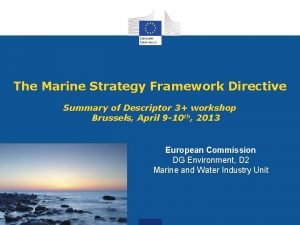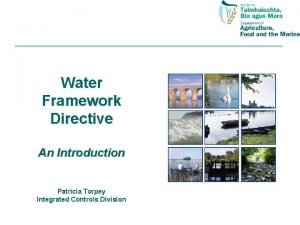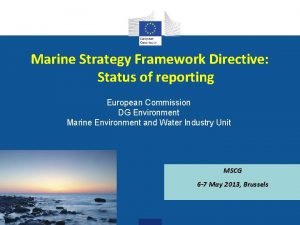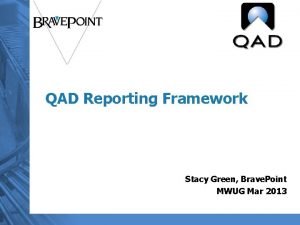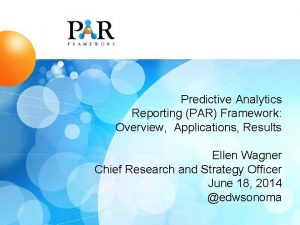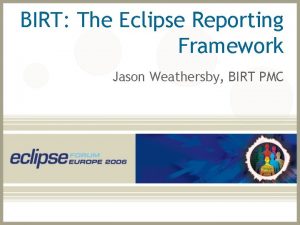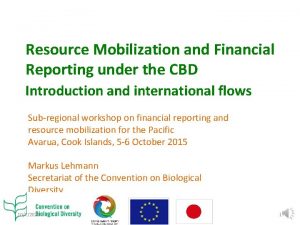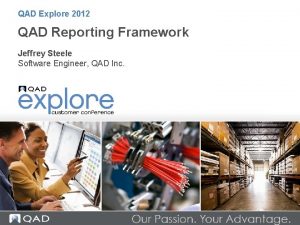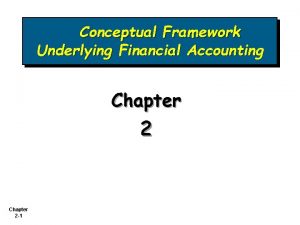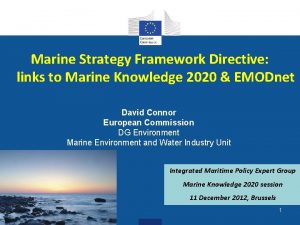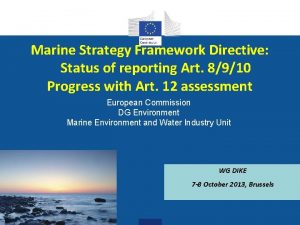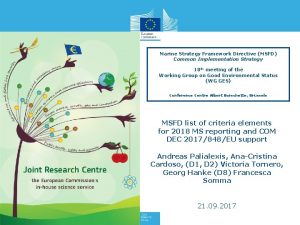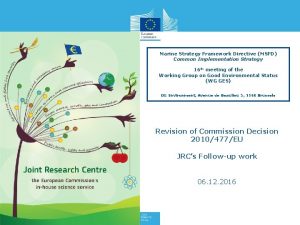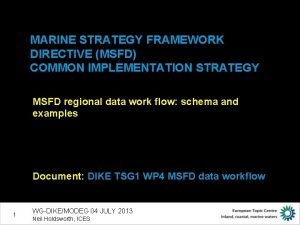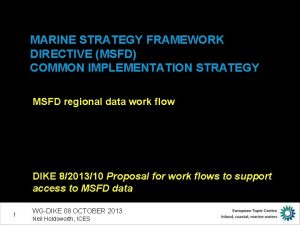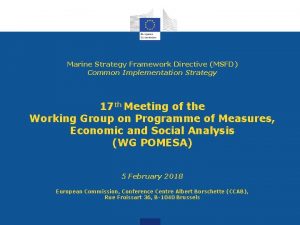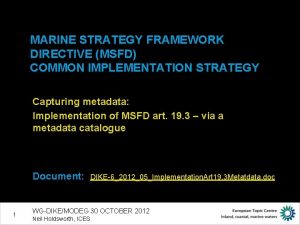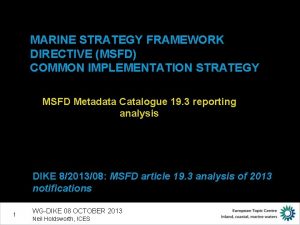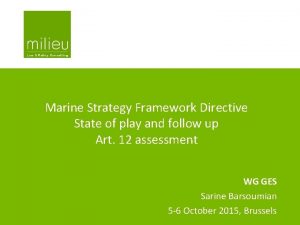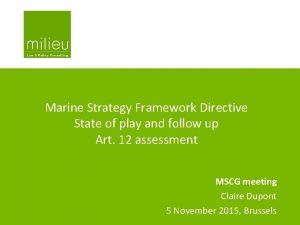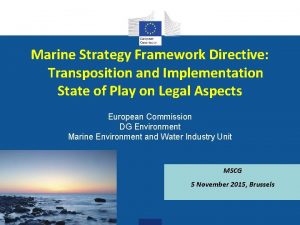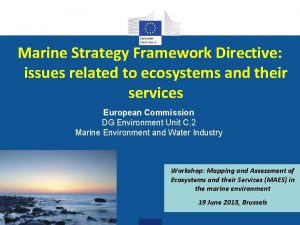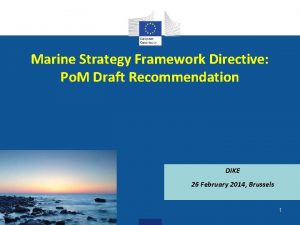Marine Strategy Framework Directive Streamliningharmonisation of reporting A


















- Slides: 18

Marine Strategy Framework Directive Streamlining/harmonisation of reporting - A worked example: eutrophication Corinne Martin, Conor O’Kane 8 th meeting of WG DIKE, Brussels 07 -08 Oct 13

Context u MSFD offers the opportunity to harmonise/streamline reporting requirements with those of other EU instruments, and Regional Seas Conventions (RSCs) u 2012: high-level screening analysis of harmonisation/streamlining potential across: n 8 EU Directives: e. g. Shellfish, Nitrates, WFD, UWWT, Birds, Habitats, CFP DCF, Bathing waters, n 4 RSCs: Barcelona, HELCOM, OSPAR and Bucharest u 2013: in-depth analysis for key topics of MSFD, e. g. Eutrophication, Biodiversity (fish), etc

2013 analysis u Aims: n Reduce burden of reporting by Member States (MS) n Avoid duplication of reporting n Enhance data usefulness u… by understanding the degree of: n Overlap (linkages), and n Complementarities n … taking into account the nature of reported information u… so as to identify options for harmonisation/streamlining across the various instruments/RSCs

Eutrophication reporting u Main EU “instruments” selected: n Water Framework Directive (WFD) Nitrates Directive Urban Waste Water Treatment Directive (UWWTD) n EEA’s Annual Management Plan (Reportnet) n n u EU-relevant n n RSCs: Barcelona Convention (Mediterranean Sea) Bucharest Convention (Black Sea) HELCOM (Baltic Sea) OSPAR Convention (Northeast Atlantic) u Restrict analysis to what is reported by MS u Descriptor 5 for Good Environmental Status (GES) under the MSFD

Methodology (1) u Analysis n framework: MSFD reporting sheets: Art. 8 (initial assessment): Nutrient and organic matter enrichment; Art. 9 (determination of GES); Art. 10 (environmental targets); Art. 11 (monitoring programmes); Art. 13 (programmes of measures) information on frequency (timing) and spatial extent of reporting requirements u Collect Frequency of reporting under MSFD

Methodology (2) Analysis framework for content of reporting:

Methodology (3) u Assign n overlap score for content of reporting: 2: good overlap (usable directly for MSFD reporting) 1: partial overlap (usable partially) 0: no overlap taking into account the nature of reported information: u… n n Data products Assessments Other (e. g. descriptive text, lists of…)

Methodology (4) Colour-coding to reflect the nature of reported information:

Results (1): frequency

Results (2): spatial coverage

Results (3): content

Results (4): content

Options for harmonisation/streamlining (1) u 16 recommendations n n 8 general ones 8 specific to eutrophication u General recommendations: 1. Develop a clearer vision of what outcomes streamlining/harmonisation is to achieve and how Ensure consistent visions across instruments and RSCs Only report data/information that are actually used in assessments 2. 3.

Options for harmonisation/streamlining (2) 4. 5. 6. 7. 8. Maintain up to date data/information in decentralised Web-servers Prioritise streamlining/harmonisation work across EU instruments, and then reach out to RSCs Identify existing good practice streamlining/harmonisation examples Creation of controlled vocabularies of terms that can be used in reporting Frame integration of reporting around a conceptual model based on DPSIR rather than around specific policies

Driving forces, Pressures, States, Impacts, and Responses (DPSIR) Source: Kristensen P. (2004) http: //enviro. lclark. edu: 8002/rid=1145949501662_742777852_522/DPSIR%20 Overview. pdf

Options for harmonisation/streamlining (3) u Recommendations specific to eutrophication: 9. Prioritise streamlining/harmonisation work on “data” and “other” reporting requirements Take advantage of “inside” knowledge /experience from NFPs “wearing several hats” Streamline MSFD reporting against OSPAR reporting requirements as part of a pilot exercise Identify spatial similarities between EU instruments/RSCs 10. 11. 12.

Options for harmonisation/streamlining (4) 13. 14. 15. 16. Create a portal to support reporting on eutrophication across instruments/RSCs Promote collaboration between national focal points Identify synergies with work programmes of RSCs’ and the Joint Research Centre Ensure definitions of eutrophic waters are unified across instruments/RSCs

Next steps u Apply this model to other MSFD topics, e. g. : Biodiversity (e. g. fish) n w – started: (e. g. CFP DCF, Habitat Directive, Convention on Biological Diversity, etc) n n u Hazardous substances Non-indigenous species … though the approach might need adapting
 Eu marine strategy framework directive
Eu marine strategy framework directive Waste framework directive
Waste framework directive çerçeve direktif nedir
çerçeve direktif nedir Msfd
Msfd Qad reporting framework
Qad reporting framework Predictive analytics reporting (par) framework
Predictive analytics reporting (par) framework Us gaap conceptual framework
Us gaap conceptual framework Java reporting framework
Java reporting framework Curriculum assessment and reporting framework
Curriculum assessment and reporting framework Cbd financial reporting framework
Cbd financial reporting framework Chapter 2 conceptual framework for financial reporting
Chapter 2 conceptual framework for financial reporting Qad reporting framework
Qad reporting framework Curriculum assessment and reporting framework
Curriculum assessment and reporting framework Chapter 2 conceptual framework for financial reporting
Chapter 2 conceptual framework for financial reporting Dispositional framework vs regulatory framework
Dispositional framework vs regulatory framework Theoretical and conceptual framework example
Theoretical and conceptual framework example Franmework
Franmework Theoretical framework
Theoretical framework Dispositional framework vs regulatory framework
Dispositional framework vs regulatory framework
